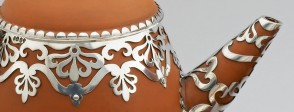Show students an image of the Wedgwood tea set. Ask them to identify the materials used to make it. What evidence is there to suggest that this tea set belonged to a wealthy person? In what other ways could a potter make a teapot look more desirable and valuable? Ask the students to imagine the silver decorations were not there. How would they think differently about the tea set? Explain who the client was for the tea set. Why do they think Wedgwood chose to decorate a modest tea set rather than making a very expensive one?
Look at the trade cards in A bigger picture. If an address is given, find out where the premises of these traders were and whether they still exist today. In what ways do the cards try to convince the customer that the proprietors are selling good-quality tea? List the different motifs and imagery used and discuss the messages they are intended to convey. If you can see the type of tea being sold, try finding out more about it.
Discuss the satirical cartoon in For the classroom – notice the British lion pulling at the Chinese man’s clothes. Consider the motivations behind Britain’s involvement with China in the 18th and 19th centuries. Why did the British promote the opium trade in China? How fair do the students think the cartoon is? Do they think that Britain relied more on China than China on Britain during the 19th century? Watch the BBC video on the Opium War in For the classroom. Afterwards, discuss whether or not they think the Opium War was justified and what view the video takes. Consider the question posed: Was the British Empire a force for good?
Look at the Treaty of Nanking in For the classroom. Read what it says and identify the British signatures and Chinese seals. Show students the print of the signing of the Treaty in A bigger picture and the key to identify those present. Ask them what they notice about the people attending. Why do they think there were so few Chinese present? Identify and discuss details such as the comments on the key and the translation of the Chinese seal. How different do they think the print would look if it were made by a Chinese artist?
A variety of far-reaching enquiries can be started from this tea set.
What did a cup of tea cost in 1840?
Ensure that the students understand what this set is and what the different vessels are for. Identify tea, milk and sugar as the three components of the drinking of tea and explore these in the context of 1840 – start with the information in the BBC History of the World in 100 objects programme in About the object.
What is meant by an industrial revolution?
Use the Wedgwood manufacturers as a case study of the impact of industrialization on manufacturing processes and the lives of its workers. Identify the transition between water and steam power in the Wedgwood factory. This enquiry could be used to provide the basis for a discussion by students in role as factory owner and pottery workers.
Why do the British drink tea?
Using the tea set, explore how tea came to be the nation’s favourite drink, popular with royalty and with the masses. This is at root an enquiry into the relationship between trade and empire, but should also take into account the social context in Britain, especially in relation to temperance movements. What evidence is there to show that tea had become a popular drink among people of all classes in the 19th century?
What did they have instead of Facebook in the eighteenth century?
Wedgwood was closely connected with other industrialists and inventors of the eighteenth century through the Lunar Society. Investigate the different members of the society, how they communicated and what impact they had on British society. These resources include the Object File on Erasmus Darwin, another member of the Lunar Society (coming soon).


